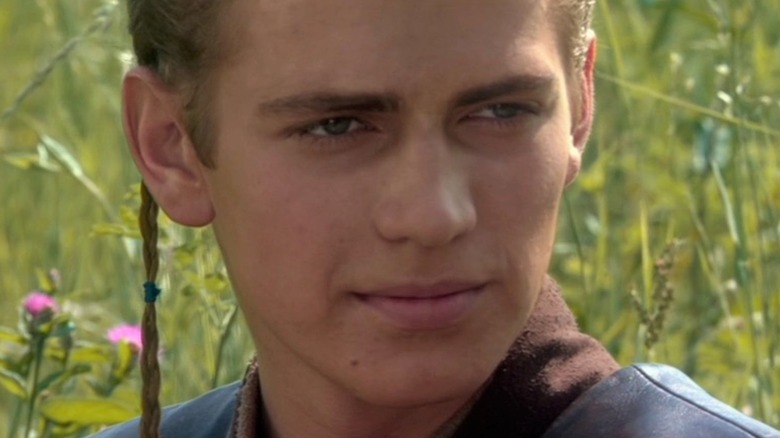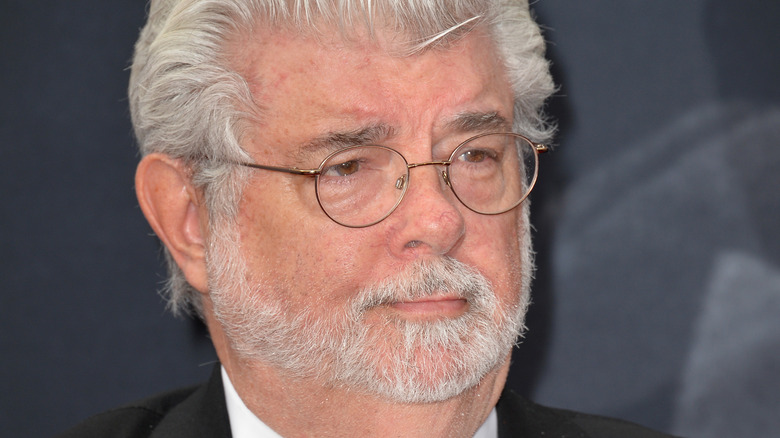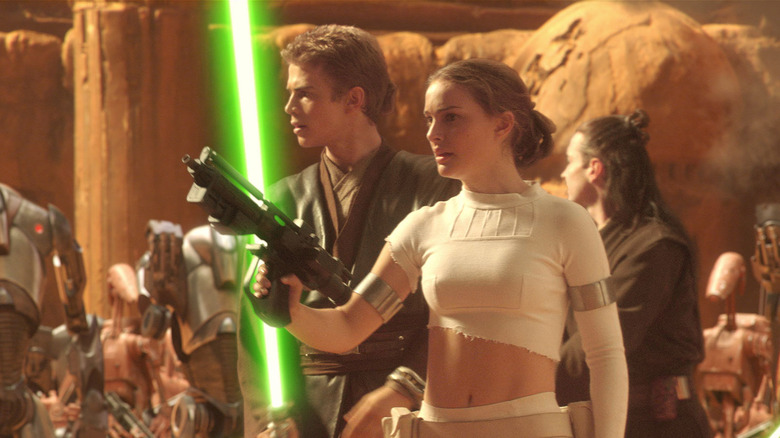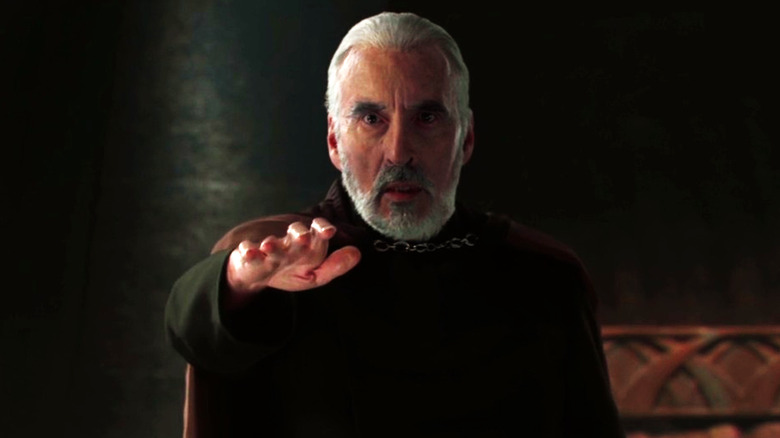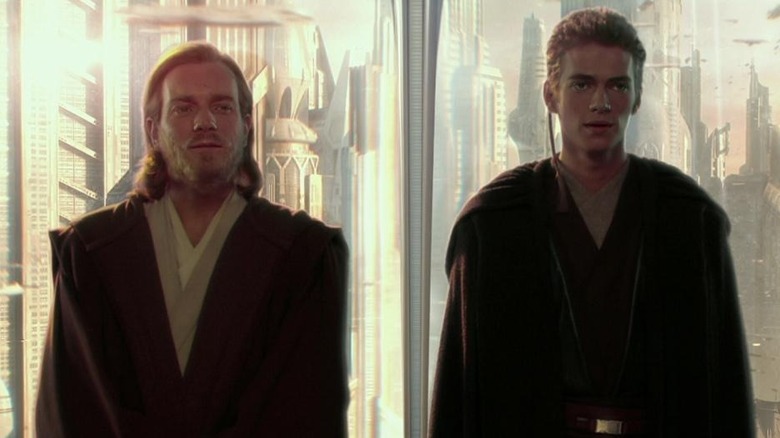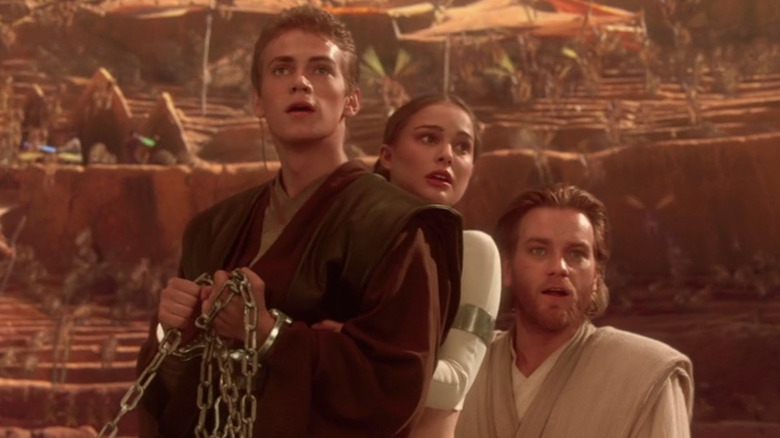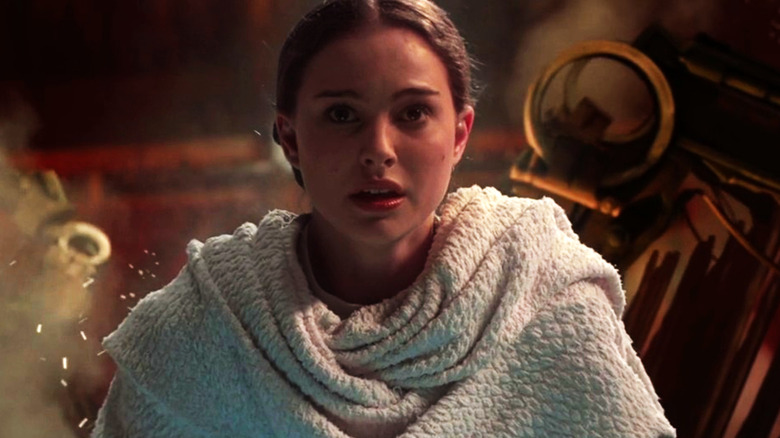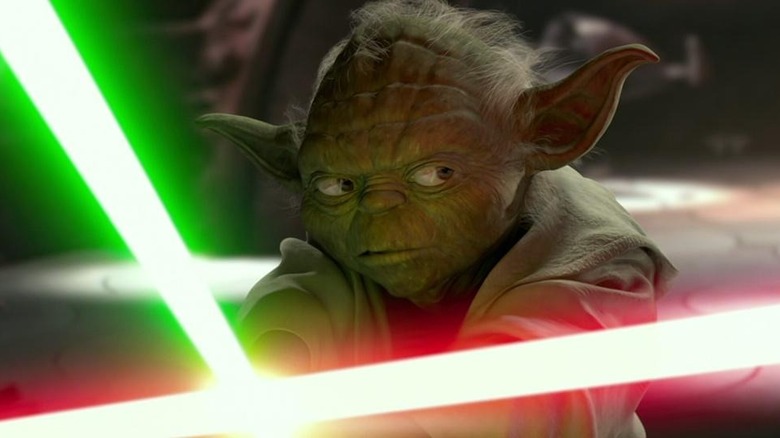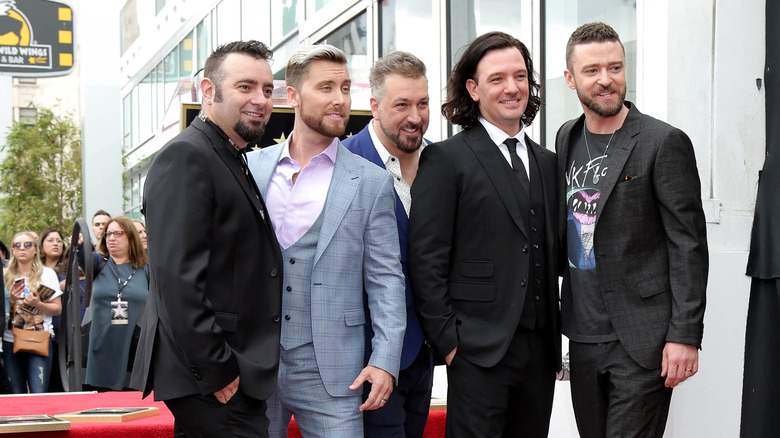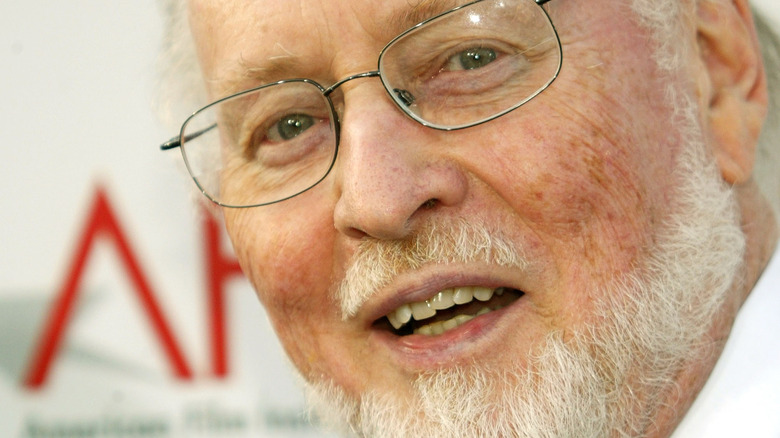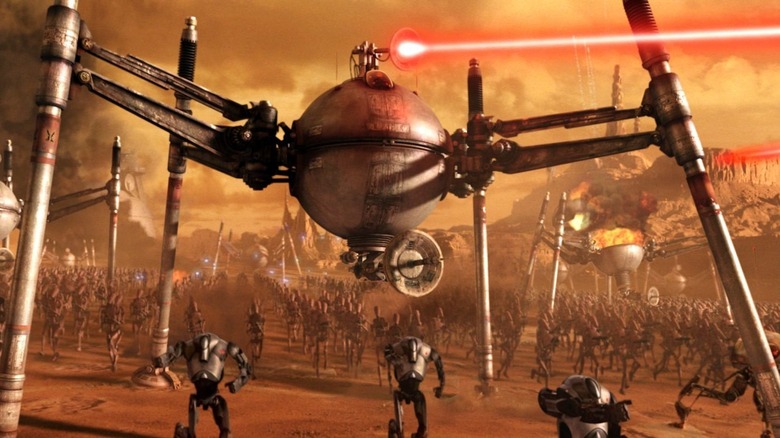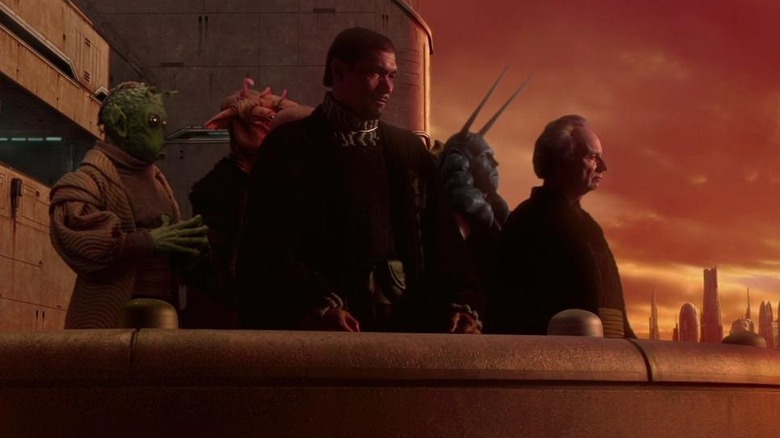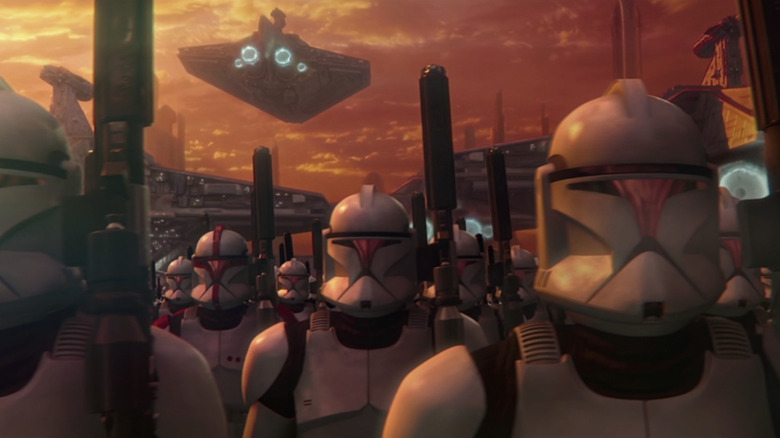The Untold Truth Of Attack Of The Clones
The first "Star Wars" movie of the 21st century, "Attack of the Clones" continued the story of the prequel trilogy that began with "The Phantom Menace," chronicling the exploits of an older Anakin Skywalker (Hayden Christensen) as he begins to fall in love with Padme Amidala (Natalie Portman) and engage in behavior teeing up his transformation into the monstrous Darth Vader. A chapter in the "Star Wars" saga oscillating between darkness and sweeping escapism, "Attack of the Clones" has been at the center of ceaseless discourse since it was released. Even with an onslaught of memes and breakdowns of its finer nuances by "Star Wars" devotees, "Attack of the Clones" still has an avalanche of little recognized details that even the movie's biggest fans may be unaware of.
From the groundbreaking filmmaking techniques to translating one of the most iconic "Star Wars" figures into CGI for the very first time to the complicated nuances of the film's box office haul, there's a lot about this movie that deserves discussion. With "Attack of the Clones," another piece of the puzzle of the "Star Wars" backstory got filled in, and the untold truth of this production reflects all the effort to bring that piece to life.
Why George Lucas made Attack of the Clones independently
It's easy to forget in the aftermath of Disney buying the entire "Star Wars" property with its $4 billion Lucasfilm purchase back in October 2012, but five of the original six "Star Wars" movies were all made independent of the traditional Hollywood system. Though these productions were distributed in theaters by 20th Century Fox, staring with "The Empire Strikes Back," George Lucas financed the "Star Wars" movies far beyond the walls of long-standing Hollywood institutions. This made this saga a fascinating outlier in the American cinema landscape — mega-blockbusters that technically counted as independent labors of love.
Talking to BBC, Lucas reaffirmed how much creative freedom he was afforded making these "Star Wars" titles without the interference of a major movie studio. While acknowledging the massive risk he took back in 1980 taking on "The Empire Strikes Back" as his first major independent blockbuster exercise, the system managed to work out well enough for decades that it only ceased to exist once Disney bought up the entire Lucasfilm enterprise.
Attack of the Clones and its use of digital photography
As noted in the September 2002 issue of American Cinematographer, "Attack of the Clones" was a historic movie given that it was the very first major feature film in Hollywood to be filmed entirely through digital cameras. This was coming at a moment when Hollywood was still torn over whether or not to fully embrace digital photography as the way of the future, with many filmmakers clinging to 35mm as the only way to film a movie. George Lucas, meanwhile, was going in the opposite direction and saw "Attack of the Clones" and its camerawork as indicative of the future of cinema.
Talking to American Cinematographer, Lucas conceded that he understood where film purists were coming from and freely admitted that wrinkles were being ironed out in the world of digital filming. However, he primarily emphasized all the benefits of digital filmmaking in this interview, including how he saw it as affording a greater level of freedom for how you could shoot scenes while also allowing him to film projects like "Attack of the Clones" in chunks rather than over one extended period of time. In the decades since "Attack of the Clones" hit theaters, digital projection and filmmaking have become the norm for Hollywood, though strong prominent support for 35mm is still ongoing. The ubiquity of the format indicates that Lucas knew which way the wind was blowing in the film industry when he made "Attack of the Clones" through digital means.
Christopher Lee's pride in being in Attack of the Clones
Christopher Lee first appeared in a feature film in 1948 and would proceed to carve out a significant presence in the world of cinema. This included appearances across some of the most famous horror films of all-time, including playing Dracula in several Hammer Horror titles and working with filmmakers as iconic as Steven Spielberg, Peter Jackson, and Martin Scorsese. However, even with so many incredible roles under his belt, Lee still felt that playing Count Dooku in "Attack of the Clones" was an unquestionable career highlight. After all, how many times does one get to wield a lightsaber or fight Yoda in their career?
While talking to BBC, Lee noted that he was grateful to be etched into "cinema history" thanks to his work as Dooku while also noting that he didn't find the difficulties of filming on a blue-screen set especially challenging, even if it did require "a pretty vivid imagination" when it came to sequences like Dooku's extended showdown with Yoda. It's no surprise Lee would take this new style of big-budget acting in stride given all that he'd seen in his career. Plus, the strains of blue-screen performances seemed to be overwhelmed by his own unabashed joy over getting to play someone in this galaxy far, far away.
The actor who made filming fun for Hayden Christensen
It can't be easy being the lead actor in a "Star Wars" movie. Having the pressure of fan and box office expectations weighing on your shoulders every day must get exhausting, especially when it's added on top of the usual anxiety-inducing factors that come with any film shoot. This was just as true for "Attack of the Clones" leading man Hayden Christensen as it was for anyone else, with the actor detailing to Entertainment Weekly that he had to spend multiple hours before a day's shooting began just getting his extensive makeup work done. After all that, he would need to spend even more hours acting against a blue screen and injecting humanity into a story about aliens and goofy robots.
However, there was one person who managed to make the whole process much more enjoyable: Ewan McGregor. In this interview, Christensen mentioned that, "Ewan was always able to lighten up any situation." Tragically, Christensen didn't give any examples of how McGregor would bring cheer to the "Attack of the Clones" set. However, their good on-set rapport was a blessing for "Attack of the Clones" given that both men were playing characters who needed to come off as good friends to make the tragic finale of "Revenge of the Sith" work. Before all that misery and betrayal, though, there were the goofy antics that made Christensen's time as a "Star Wars" lead a little more bearable.
Why Hayden Christensen was at ease while filming
"Attack of the Clones" established a new filming style for the "Star Wars" prequels that would continue with "Revenge of the Sith." The vast majority of the movie would be shot on green-screen and blue-screen soundstages, with digital environments and characters added in at a later date. While practical locations would still be utilized for certain scenes in these movies, most backdrops in "Attack of the Clones" would be artificially created. At the time, it was an unorthodox way of making movies, one that not every actor was comfortable working with. However, "Attack of the Clones" leading man Hayden Christensen managed to maintain his sanity working in these conditions and even found himself at ease acting against such sparse backgrounds.
Talking to Entertainment Weekly, Christensen acknowledged how difficult shooting these "Star Wars" movies had been for other performers like Liam Neeson, but Christensen noted that he wasn't quite as overwhelmed by it because he'd been in more stage productions than movies. Without decades of acting on more traditional film sets to compare "Attack of the Clones" to, not to mention the stage being a place where you also have to work heavily with your imagination, he managed to get along with all the madness that this production threw at him. Shooting a movie like this won't be everyone's cup of tea, but Christensen managed to make it work like gangbusters.
Natalie Portman's experiences fighting invisible monsters
Long before she secured the mantle of the Mighty Thor, Natalie Portman was Padme Amidala, the queen of Naboo, mother to Luke and Leia, and the lover to Anakin Skywalker. Though this was a role heavy on romance and trading gooey lines with Hayden Christensen, Portman did still get to score some action in the middle of big sci-fi set pieces in "Attack of the Clones." This was most notable when the story shifted to the planet of Geonosis, where Amidala, along with Skywalker and Obi-Wan Kenobi, have to evade the likes of a droid factory and three very hungry alien animals. Such sequences required a lot of training on Portman's part, even if she was puzzled by how she often couldn't see her adversaries.
Talking to Entertainment Weekly, Portman said that she did have fun with a more action-heavy role compared to her work in "The Phantom Menace." However, she did note that there was unintentional hilarity whenever she was shooting scenes where she'd have to evade and fight monsters that wouldn't exist until deep into post-production. It was a process she had no prior experience with before she embarked on "Attack of the Clones," but by the end, Portman felt she'd gotten "surprisingly good" with stunt work against invisible opponents since, according to her, "90% of [my] shots are with a tape mark against a blue screen."
The process of nailing down a CGI Yoda
For "Attack of the Clones," history would be made. For the first time in the history of the series, the character of Yoda would be entirely rendered as a computer-generated being. Previously, Yoda had been depicted only as a puppet. Even in "The Phantom Menace" (save for one wide shot), he'd still been brought to life through this technique. But as "Star Wars" entered the 21st century, George Lucas and company opted to switch it up and realize this little green Jedi through all the new possibilities of digital wizardry. It was a momentous move that instilled a lot of pressure in everyone in the visual effects department on "Attack of the Clones."
Animation director Rob Coleman explained to Cinema.com that the chance to bring Yoda to life through CG means would allow this iconic figure to be more prominent in the action sequences in "Attack of the Clones" compared to past "Star Wars" movies. Meanwhile, Coleman also noted that the team was not abandoning the character's rich past, as the work of puppeteer Frank Oz (who would still voice Yoda) in previous "Star Wars" installments would be greatly influencing the movements and body language of CG Yoda. Though using visual effects technology of the future, these creative decisions ensured that this new version of Yoda would still have one foot in the familiar past.
The saga of NYSNC's deleted cameo
Lots of recognizable faces show up throughout "Attack of the Clones," including future big names like Joel Edgerton and newcomers to the franchise like Christopher Lee. However, this entry in the "Star Wars" prequel trilogy almost featured some additional — and musical — familiar faces. Rather than another beloved "Star Wars" character or an iconic actor from classic genre cinema, "Attack of the Clones" was poised to feature a brief appearance from boy band sensation NSYNC.
Per The Huffington Post, all but two members of the band (with Lance Bass and Justin Timberlake being the holdouts) were secured for a cameo in "Attack of the Clones," which would've featured the members appearing as Jedi Knights. There were apparently two different scenes involving NSYNC filmed, with one of them placing the musicians in the middle of the epic final battle on the planet Geonosis while the other would've featured NSYNC chilling in the Jedi Temple.
No official reason has ever been given for why NSYNC got cut from the film, though speculation has pinpointed negative fan reception to the prospect of the cameo and problems with the band belonging to the Screen Actors Guild of America as possible reasons. The Huffington Post piece does speculate that the group may not have been eliminated entirely from the film, though, as one Jedi in the background in the final cut appears to be NSYNC member Joey Fatone.
The creative inspiration for the John Williams score
Over more than four decades, John Williams has been a constant presence across the "Star Wars" saga. Between all nine "Skywalker Saga" installments, Williams has been there to provide the score while his presence in the franchise even extends to creating new theme music for spinoff adventures like "Solo: A Star Wars Story" and "Obi-Wan Kenobi." Even with his enormous familiarity with this fictional universe, though, Williams is always keen to shake things up and avoid repeating himself. That's why, when it came to "Attack of the Clones," Williams emphasized the importance of constructing romantic music for scenes depicting Anakin and Padme romping around together on various dates.
This wasn't an ambiance Williams had gotten to explore musically before in these films, and he was chomping at the bit to do it right. Per Cinema.com, Williams noted that George Lucas told him that a key creative inspiration for these sequences was old romance movies from the 1930s and 1940s, with George Lucas specifically name-dropping Claudette Colbert films as something to mimic. Williams also noted that, like composers of classic romantic movies, he wanted to make sure his score would hint at "the erotic aspects" of a romantic relationship that wouldn't be seen on-screen. Balancing out such vintage influences with a splash of passion ensured that Williams would be doing anything but providing a rehash of the past with his score for "Attack of the Clones."
The reshoots for Attack of the Clones
"Attack of the Clones," like any sizeable movie, required reshoots long after principal photography was complete. In this case, "Attack of the Clones" concocted some new action set pieces. Per the bonus features on the home video release for the "Star Wars" sequel, the entire sequence set in the droid factory was one such newly crafted set piece concocted during the reshoots. Such segments were conjured up to ensure that the production was as exciting as possible. One odd byproduct of the reshoots, though, was Ewan McGregor's facial hair. During Obi-Wan Kenobi's trip to the cloning facility on Kamino, the character's beard suddenly looks noticeably different than it does in any other part of the movie.
Years later, it would be revealed that this sequence was shot during reshoots for "Attack of the Clones," which occurred when McGregor was off filming "Black Hawk Down." Having shaven off his beard for that Ridley Scott war movie, the production had no choice but to give the actor some fake facial hair for this sequence. While there were some noticeable additions to "Attack of the Clones" incorporated into the reshoots, they weren't quite as drastic as changes instilled by reshoots for other "Star Wars" movies, such as "Rogue One."
Attack of the Clones' complicated box office performance
On its domestic opening day, "Attack of the Clones" took in $30.1 million, a noticeable improvement over the $28.5 million opening day of its predecessor, "The Phantom Menace." This promising start led to an $80 million North American opening weekend, which also grew over the three-day bow of $64 million for "The Phantom Menace." However, "Attack of the Clones" would not hold nearly as well on a weekend-by-weekend basis in the months ahead, and its final domestic haul of $302.1 million would be down 30% from the original domestic gross of "The Phantom Menace."
While "Attack of the Clones" was still a hearty performer financially, thanks to earning over $650 million worldwide, it did end up getting overshadowed in 2002 by other blockbusters. In the past, a new "Star Wars" movie had been the biggest feature of its release year by a considerable margin. But in 2002, "Attack of the Clones" got outgrossed domestically and worldwide by three other titles, including "Spider-Man" and "Lord of the Rings: The Two Towers." All that extra competition in the world of blockbusters, not to mention the noticeable decrease overall from "The Phantom Menace's" lifetime box office gross, meant that even a movie exceeding $650 million worldwide like "Attack of the Clones" couldn't help but feel like it could've done even better financially.
Attack of the Clones was the first Star Wars movie to play in IMAX
In the modern world of blockbusters, it's strange if a big-budget title doesn't get a simultaneous IMAX release. Once the domain of nature documentaries and other specialty titles, now everything from "Focus" to "Morbius" gets IMAX showings. But back in 2002, the idea of traditional narrative films playing in those larger screens was still far from common. "Attack of the Clones" broke major ground in this regard when it was re-released into IMAX venues in November 2002, complete with remastered sound and picture to take full advantage of these auditoriums.
Of course, the release wasn't perfect, particularly when it came to the film's runtime. Because of the restrictions of IMAX projectors in this era, films couldn't exceed 2 hours and run in IMAX. Thus, "Attack of the Clones" had to trim a few minutes of its runtime to make it into these larger-scale theaters. But that was a small price to pay for "Attack of the Clones" to score the historic feat of being the first "Star Wars" movie to play in IMAX locations. What was unprecedented in 2002 is now common in the modern world, as all the Disney-owned "Star Wars" films have played in IMAX venues
